This Definitely Beats the “Mac Shelf”
Saturday, August 5th, 2006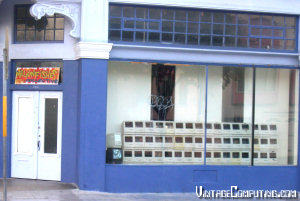
I have the feeling that a Simunovich is behind this piece of techno-art. Devan, that is.

I have the feeling that a Simunovich is behind this piece of techno-art. Devan, that is.
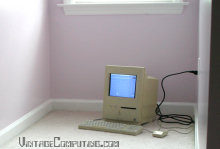 For those of you who didn’t know or don’t remember, the reason why VC&G has been quiet lately is because I’m in the middle of moving to a new house. After I’m settled, things will be back to normal (I also got married on May 1st. So you can imagine that I’ve been quite busy). Until then, I’ve got a few pictures for you. The first picture (above) is of the first computer I set up in my new house. It’s a Mac Color Classic that I’m currently slowly playing The Secret of Monkey Island on (great game, by the way). I set it up in a little dormer nook in an otherwise empty room upstairs. In lieu of proper furniture, it gets the next best thing: the floor. When the hustle and bustle of all the moving gets to me, I can retreat to my “Mac room” and relax. But not for very long, of course, because there are plenty more computers to move! Chop chop!
For those of you who didn’t know or don’t remember, the reason why VC&G has been quiet lately is because I’m in the middle of moving to a new house. After I’m settled, things will be back to normal (I also got married on May 1st. So you can imagine that I’ve been quite busy). Until then, I’ve got a few pictures for you. The first picture (above) is of the first computer I set up in my new house. It’s a Mac Color Classic that I’m currently slowly playing The Secret of Monkey Island on (great game, by the way). I set it up in a little dormer nook in an otherwise empty room upstairs. In lieu of proper furniture, it gets the next best thing: the floor. When the hustle and bustle of all the moving gets to me, I can retreat to my “Mac room” and relax. But not for very long, of course, because there are plenty more computers to move! Chop chop!
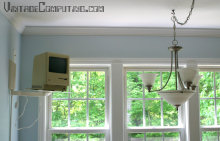 Remember my “Compact Mac Shelf?” Well, I’ve had to leave that luxury behind. The closest I can get to that in my new place is what you see here. The previous owners left this wall-mounted TV stand in the kitchen, and upon first seeing it, I didn’t think “TV.” I thought…well, you can tell what I thought, because the picture illustrates it quite vividly. Anyway, if the wife lets me, I might rig up some sort of useless-but-fun interactive Mac art installation. Then again, it’s likely that we’ll actually just put a color TV up there (if we ever get one that size). Still, I thought the new “Mac Shelf” was worth a picture.
Remember my “Compact Mac Shelf?” Well, I’ve had to leave that luxury behind. The closest I can get to that in my new place is what you see here. The previous owners left this wall-mounted TV stand in the kitchen, and upon first seeing it, I didn’t think “TV.” I thought…well, you can tell what I thought, because the picture illustrates it quite vividly. Anyway, if the wife lets me, I might rig up some sort of useless-but-fun interactive Mac art installation. Then again, it’s likely that we’ll actually just put a color TV up there (if we ever get one that size). Still, I thought the new “Mac Shelf” was worth a picture.
That’s all for now. I’ll still be chatting some in the VC&G Forums before I get back up to full steam again, so join in the fun (Haven’t joined yet? Why not?). And don’t worry — more interesting and original VC&G articles are definitely on the way.
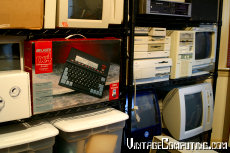 On an unusually personal note for VC&G, I thought I’d let you guys know why I’ve been so quiet recently. The answer is completely on-topic and has a lot to do with what is pictured on the right: computers. You see, I’m about to move. Moving is no simple operation for anyone, but it becomes exponentially more complicated when your house is filled with over one thousand cubic feet (wild estimate, maybe more) of bulky computers, their accessories, and video game systems. I’ve not even actually started moving yet, but I’ve spent the last few weeks packing things up and getting things ready for the big haul. Phew. Next Wednesday the actual move begins, and I’m planning on renting a big truck to move as much as I can in as few loads as possible. I’ll probably take some pictures to show you later.
On an unusually personal note for VC&G, I thought I’d let you guys know why I’ve been so quiet recently. The answer is completely on-topic and has a lot to do with what is pictured on the right: computers. You see, I’m about to move. Moving is no simple operation for anyone, but it becomes exponentially more complicated when your house is filled with over one thousand cubic feet (wild estimate, maybe more) of bulky computers, their accessories, and video game systems. I’ve not even actually started moving yet, but I’ve spent the last few weeks packing things up and getting things ready for the big haul. Phew. Next Wednesday the actual move begins, and I’m planning on renting a big truck to move as much as I can in as few loads as possible. I’ll probably take some pictures to show you later.
To all our readers, and to all the people who have emailed me something that I haven’t replied to / published yet, I want to say thank you for your exceptional patience. Once I’m up and running in my new office, I’ll be pumping out new VC&G features like never before. That should be in a couple weeks at the most. I’ve got tons of cool stuff in the pipeline (including an account of my recent adventure to a local hamfest that resulted in some excellent finds), so stay tuned! Subscribe to VC&G articles via RSS and you’ll know automatically when we’re back in action.
Wish me luck on moving the mountain. If I get crushed under a PDP-11 in the process, don’t cry for me; at least I will have died moving something I loved. 😛
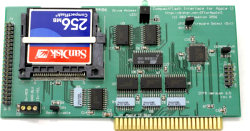 I’ve never been a huge fan of using emulators for any computer that I actually physically possess. The original hardware is almost always where it’s at — the unique look, the feel, and even the smell of a machine all add to the “authentic” user experience (kinda makes me sound like a wine snob, doesn’t it?). But original hardware breaks over time and sometimes becomes irreplaceable since it’s no longer in production. That’s where people like Rich Dreher step in with modern upgrades for vintage computers (for more on this phenomenon, check out my “New Tech for Old Computers & Game Systems” list).
I’ve never been a huge fan of using emulators for any computer that I actually physically possess. The original hardware is almost always where it’s at — the unique look, the feel, and even the smell of a machine all add to the “authentic” user experience (kinda makes me sound like a wine snob, doesn’t it?). But original hardware breaks over time and sometimes becomes irreplaceable since it’s no longer in production. That’s where people like Rich Dreher step in with modern upgrades for vintage computers (for more on this phenomenon, check out my “New Tech for Old Computers & Game Systems” list).
Rich is now on the second revision of an impressive Apple II hardware add-on card he designed called the “CFFA” that enables any Apple II system to use a compact flash card, IBM MicroDrive, or IDE hard drive for storage. While definitely not the first Apple II IDE interface I’ve seen (or owned), this is a very slick piece of hardware. Here’s a brief rundown of its features, taken from the official site:
- Standard Apple II form factor Card 3″ x 6″ (Usable in any slot, except slot 3 in IIe and later)
- A Compact Flash/IDE Interface for Apple II family of computers (Type II Compact Flash socket — IBM MicroDrives work too)
- Standard 40 pin IDE header connector
- 3 terminal screw type power connection for IDE hard drives
- Support for up to 128 MB (4 drives) or 256MB (8 drives) under ProDOS and GS/OS (without Dave’s GS/OS driver)
- Support for up to 128MB, (four ProDOS 32MB drives) plus two 1GB drives under GS/OS (with Dave Lyons’ GS/OS driver)
- On-board EEPROM for SmartPort firmware
- User jumper to select 1 of 2 versions of the firmware
- Allow booting ProDOS or GS/OS directly from the Interface card (for a floppy-less system)
- Firmware available for 6502 machines (II, II+, IIe) and 65C02 machines (IIe enh, IIe platinum, IIgs ROM1 & ROM3)
Particularly attractive is, of course, the built-in CF socket. I recently read on Rich’s site that there’s even a new utility called “CiderPress” that will let you transfer files to / from the Apple II-formatted CF card when it’s plugged into a Windows machine!
Despite all its neat capabilities, what is actually most important about this card is that it’s actually for sale (currently US $105 plus shipping). Extremely unique short-run hardware doesn’t stay around for very long, so if you’re interested, don’t hesitate to jump on it while you still can. I’ve already got mine on order and am looking forward to running my Platinum IIe from a compact flash card soon.
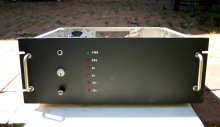 [RedWolf writes: “This story was written by K4DSP, who is an old and dear friend of mine (and a fellow computing and technology enthusiast). He sent it to me recently and I enjoyed the story so much that I thought I would share it with you.”]
[RedWolf writes: “This story was written by K4DSP, who is an old and dear friend of mine (and a fellow computing and technology enthusiast). He sent it to me recently and I enjoyed the story so much that I thought I would share it with you.”]
1982 was an exciting time for computer enthusiasts. The personal computer market was still in its infancy, and there were literally dozens of different models available at all sorts of price points. As a poor college student studying engineering and computer science, I found nearly all of them out of my reach financially, but the one I really lusted after was the Apple 2. I constantly imagined all the great software I could write and all the games I could play if I only had one of these 1 MHz 8-bit screamers. Never mind the Ataris and Commodores and Sinclairs and the multitude of CP/M machines — the Apple II was the one for me.
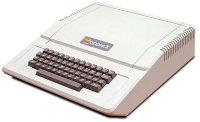 There was one insurmountable obstacle between the Apple and me. At $1195 it was literally the equivalent of six months’ rent. It might as well have been a million dollars. So I looked for alternatives. I thought about building a computer. In the early 80s it wasn’t all that unusual for people to build their own computers from scratch, but it wasn’t like homebuilt computers today – you didn’t go to a computer store and buy a motherboard and CPU and case and power supply and hard drive and bolt it all together and pop in your Windows install CD. Building computers meant soldering and drilling and (sometimes) even writing your own software to make things work. When the Apple II came out in 1977 it was one of the first “store bought” computers that didn’t require any assembly. That’s one of the reasons I wanted one. As a full time student with a job and a wife I really didn’t have time to figure out how to build a computer from scratch.
There was one insurmountable obstacle between the Apple and me. At $1195 it was literally the equivalent of six months’ rent. It might as well have been a million dollars. So I looked for alternatives. I thought about building a computer. In the early 80s it wasn’t all that unusual for people to build their own computers from scratch, but it wasn’t like homebuilt computers today – you didn’t go to a computer store and buy a motherboard and CPU and case and power supply and hard drive and bolt it all together and pop in your Windows install CD. Building computers meant soldering and drilling and (sometimes) even writing your own software to make things work. When the Apple II came out in 1977 it was one of the first “store bought” computers that didn’t require any assembly. That’s one of the reasons I wanted one. As a full time student with a job and a wife I really didn’t have time to figure out how to build a computer from scratch.
[ Continue reading How I Got My First Computer,
and How I Got My First Computer Back » ]
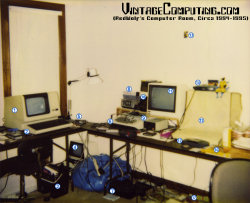 Late last year I found this classic (for me, anyway) picture lurking in my files and scanned it. It’s a Polaroid photograph of one corner of my then “computer room” taken by myself somewhere around late 1994 or early 1995 (yes, my family was lucky enough to have the space for another room dedicated mainly to my BBS computer, but filled with my other junk as well). I was 13 or 14 at the time. As you can see on the picture, I’ve labeled certain items in the room with numbers. Each number is associated with an item that I talk about below. With that out of the way, click on the image to open up the bigger version and let’s start the tour!
Late last year I found this classic (for me, anyway) picture lurking in my files and scanned it. It’s a Polaroid photograph of one corner of my then “computer room” taken by myself somewhere around late 1994 or early 1995 (yes, my family was lucky enough to have the space for another room dedicated mainly to my BBS computer, but filled with my other junk as well). I was 13 or 14 at the time. As you can see on the picture, I’ve labeled certain items in the room with numbers. Each number is associated with an item that I talk about below. With that out of the way, click on the image to open up the bigger version and let’s start the tour!
1. DEC VT-125 Terminal – A true classic in the terminal world, pulled from a dumpster. The neighbor of my father’s company serviced minicomputers and was always throwing neat stuff out. I got about 3-4 of these, took a few apart, eventually throwing them away for space concerns. But I think I still have one or two left.
2. Micromint Z8 Board – Part of the Micromint Z8 Basic Computer/Controller set. Inherited from my father’s old workplace. The Micromint Z8 system was a BASIC language-programmable microcontroller, essentially for early “embedded computer” applications. I have a bunch of cool expansion boards too, including one that lets you save/load your program to cassette tape, and another that lets you burn EPROMs of your BASIC programs! Cool stuff — I should play with it again.
3. NES Games – Back in 1994, my NES game collection could actually fit in one cubic foot of space. Crazy. A NES Game Genie code book can be seen here, awkwardly sticking out of the top of the plastic basket. Eventually my collection would spill out of the pictured basket and beyond…
4. Commodore CBM 2001-32 – This was had at a hamfest for $10, including the separate companion disk unit. It’s tucked away in the far back corner of the room, so I guess I didn’t use it very much.
5. Zoom 2400 BPS Modem – My first modem, given to my family by a friend. The top cover is off because I was playing around with hooking the speaker audio output to headphones — both for kicks, and for late-night modem sessions without waking the parents (I did this before I figured out the Hayes AT command to turn off the internal speaker) . This very modem is responsible for introducing me to the world of BBSes sometime in 1991. Of course, this being 1994-95, my main workhorse at the time is an Intel external 14400 modem across the room (not pictured).
6. Apple II+ – My dad bought this for me around 1990-91 (from a hamfest, big surprise) so I could learn BASIC on it. And I did, having loads of fun with it over the years. At the time of this picture I had the luxury of a color composite video monitor (#11). Up until then, I was stuck with a monochrome green-screen. But somehow it almost didn’t feel like an Apple II any more once it was in color.
7. Odyssey2 Games – Yes, this black blob is actually fifteen Odyssey2 games in interlockable cartridge racks, purchased for $10 along with an Odyssey2 console at a hamfest in the early 90s.
8. Nintendo Entertainment System – Back then, I took everything I owned apart, and the former “family NES” was not spared this treatment. Thinking myself clever, I switched the one and two player ports around, along with the “power” and “reset” buttons. How delightfully obnoxious. This unit, 11 years later, went on to become the NES DVD Player hack I did recently.
9. EPROM Eraser – It’s the gray rectangular box on top of the Apple II+ (#6). Never really used it very much. It was inherited along with the Micromint Z8 controller board stuff (#2) and was used to erase EPROMs programmed by the unit. It works by shining UV light through a tiny quartz window on the EPROM.
10. Apple II Disks – Stacked here are two boxes of Apple II disks. The lower one is mine, the upper one was given to me by a friend (with all his Apple II disks in it!). In fact, it was the same friend who gave my family the 2400 BPS modem (#5). It’s nice to have good friends.
11. Composite Video Monitor – What a grand day it was when I acquired my first color composite video monitor at a local hamfest! In this picture, the monitor is performing triple duty between the Apple II+ (#6), NES (#8), and Atari Jaguar (#14). I simply switched the AV connectors at the back depending on which one I wanted to use.
12. Atari Lynx – I bought this under-utilized portable wonder in used condition from a guy who regularly called my BBS (“Raven,” if you must know) in 1993 or 94. The transaction was done entirely by mail and we never met in person (imagine that!).
13. Mystery Sticker – I’m not sure what this is. It looks like a random peel-off trading card-sized sticker just stuck on the wall at an odd angle. Weird. This picture have been taken after my dad made me take down the 100-odd posters and other crap I had tacked and taped all over the walls, believing they were a fire hazard.
14. Atari Jaguar – I was a total Atari nut in the very early 90’s, believing strongly that Atari was the greatest company ever. “What’s this Nintendo business?” I said. “Atari was first!” I heard rumors of their Panther, then Jaguar, consoles and waited anxiously for their release. My birthday in 1994 was one of the happiest days of my life: I received an Atari Jaguar System and Super Metroid for the SNES. Here, Doom can be seen in the cartridge slot, a version of the seminal 3D FPS rivaled on consoles only by the PlayStation version.
15. Apple III – The prize of my collection at the time. When I first heard about the Apple III years before, it was like some magical, mythical beast. Would I ever catch sight of one, much less possess it? Naturally, I was extremely excited when my father and I came across this one later at a hamfest (again, big surprise). $10-20 later, I had my first Apple III, complete with dust cover (pictured on the unit). I only had the Apple II emulation disk for it, though, and to this day have never run any native Apple III software. Shortly after my Apple III was obtained (turned out they were not as rare as I thought), the Apple Lisa quickly became the next mythical beast to be had — a beast I’m still chasing in the wild to this day.
16. Plug ‘N’ Play Mosaic Book – This book is how I got my first copy of Mosaic, the first graphical web browser (it came on a floppy disk in the back). Shortly after, I began to develop my first home page, and boy did it suck. It’s funny reading lists of “cool” web sites from back then because, well…there were only about ten web sites back then. Ergo, all of them were cool (and listed in this book).
17. Handheld Video Games Magazine – I just found this particular issue (Spring 1991) again recently while working on my “Game Ads A-Go-Go” column for GameSetWatch. Good issue. I apparently didn’t value it very much at the time because it’s sitting on the floor right next to the spot where our cats would leave all the dead birds they’d caught that week. Yum.
Well that’s the tour, hope you enjoyed it. Thanks for accompanying me on a nice walk down memory lane.
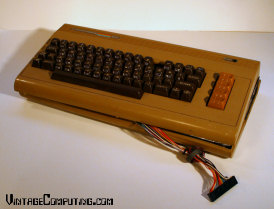 I have a box of about eight musty, “doorstop quality” Commodore 64’s (C64) and VIC-20’s sitting up in my attic. They came from a local hamfest a few years ago. It was getting late in the show that day and the vendors were tired and wanted to go home. At the end of any hamfest, vendors have tons of near-worthless, unsold, bulky junk that they’d usually rather throw away than drag back to their car. I have been stuck in a situation at least four or five times where I was interested in buying one item, but would only be allowed to purchase the item if I agreed to haul off all kinds of other crap for the seller. In this case, I just wanted to buy a single box of C64 disks that I noticed sitting on a table, but the guy would only sell it to me if I agreed to take six C64s, five Vic-20s, a few disk drives, lots more accessories and carts, and…well, there wasn’t just one box of disks, after all, but more like ten. It was like some Vaudeville routine: as soon as I thought the seller had pulled the last box of Commodore-spew from under the table and turned to leave, he’d say “oh wait!” and pull out another one. At this point my father, who was saddled with the unenviable task of helping me carry all these musty artifacts to our car, had a severe grimace on his face. That day I inherited some guy’s entire Commodore collection for $10, including his massive anthology of pirated C64 game disks (complete with a thick three-ring-bound index to the disks!), and I think my dad inherited some permanent “Commodore grimace” lines in his forehead.
I have a box of about eight musty, “doorstop quality” Commodore 64’s (C64) and VIC-20’s sitting up in my attic. They came from a local hamfest a few years ago. It was getting late in the show that day and the vendors were tired and wanted to go home. At the end of any hamfest, vendors have tons of near-worthless, unsold, bulky junk that they’d usually rather throw away than drag back to their car. I have been stuck in a situation at least four or five times where I was interested in buying one item, but would only be allowed to purchase the item if I agreed to haul off all kinds of other crap for the seller. In this case, I just wanted to buy a single box of C64 disks that I noticed sitting on a table, but the guy would only sell it to me if I agreed to take six C64s, five Vic-20s, a few disk drives, lots more accessories and carts, and…well, there wasn’t just one box of disks, after all, but more like ten. It was like some Vaudeville routine: as soon as I thought the seller had pulled the last box of Commodore-spew from under the table and turned to leave, he’d say “oh wait!” and pull out another one. At this point my father, who was saddled with the unenviable task of helping me carry all these musty artifacts to our car, had a severe grimace on his face. That day I inherited some guy’s entire Commodore collection for $10, including his massive anthology of pirated C64 game disks (complete with a thick three-ring-bound index to the disks!), and I think my dad inherited some permanent “Commodore grimace” lines in his forehead.
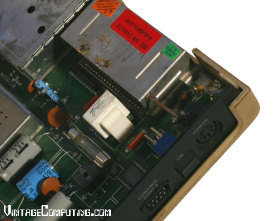 I climbed up into my fiberglass dust-ridden attic the other day, looking for an ideal donor of a 6510 processor to add to my CPU collection. Temptingly, in my Commodore box there was a C64 already apart and in pretty bad shape — an ideal sacrificial Commie to dissect. Upon bringing it down and looking inside the case, I found something pretty amusing: some guy — presumably the previous owner — was fiddling with the power connector in the unit and somehow broke the ground contact and corresponding pin off the connector. It looks to me like he was in the middle of laboring to remove the connector when he was abruptly struck with Sudden Onset Lack-Of-Patience Disorder (or SOLOPD, a common affliction amongst electronics tinkerers). Soon after, his strategy for connector removal became “rip it off any way you can.” Unsurprisingly, he broke his machine in the process. Through the magic of literary time travel, we can infer what obviously happened afterwards as he attempted a repair:
I climbed up into my fiberglass dust-ridden attic the other day, looking for an ideal donor of a 6510 processor to add to my CPU collection. Temptingly, in my Commodore box there was a C64 already apart and in pretty bad shape — an ideal sacrificial Commie to dissect. Upon bringing it down and looking inside the case, I found something pretty amusing: some guy — presumably the previous owner — was fiddling with the power connector in the unit and somehow broke the ground contact and corresponding pin off the connector. It looks to me like he was in the middle of laboring to remove the connector when he was abruptly struck with Sudden Onset Lack-Of-Patience Disorder (or SOLOPD, a common affliction amongst electronics tinkerers). Soon after, his strategy for connector removal became “rip it off any way you can.” Unsurprisingly, he broke his machine in the process. Through the magic of literary time travel, we can infer what obviously happened afterwards as he attempted a repair:
There he was, cradling the lifeless body of a broken C64 in his arms, crying and cursing himself for his impatience and uneven temperament. He broke down on his knees and swore to the heavens to never harm another 64 again if only the Commodore Gods would ease his suffering and forgive him for his mistake. But alas — his cries of desperation fell only on deaf ears (the 22 year-old family cat). And like any man whose most desperate call goes unheard, something turned inside him. For a brief moment, all that was dark and cruel welled up within him, twisting his soul in queer ways as a streak of fiery evil flashed over his hollow eyes. He raised his arms, clutching the helpless computer over his head, and nearly bashed the faulty unit into the darkest form of oblivion. But at the last moment, something stopped him: a key from the unit fell to the floor beneath him. It was the “plus” key — the very first key he pressed on the greatest day of his life. Vivid images of his 15th birthday flooded his head, filling him with a deep sense of regret over what he almost did. It was on that day that he received the very machine he was clutching from his late grandfather. How could he forsake old Roy — always happy, smiling, and helpful — and the desire for a better life that he handed down to his only grandson in the form of a $300 personal computer? It was then that the man decided that he should spare the machine; he would fix it. But how would he achieve such an impossible task? He didn’t have any spare C64 power connectors, and, after all, replacing the connector required removing the old one — the very problem that got him into this mess to begin with! Frantically searching for a solution, he scratched through his junk box until his fingers nearly bled. In the dustiest, farthest back corner of his tattered box, he found it: a nail. Yes! He thought back to his summer job as a carpenter with his grandfather’s construction business — lesson number one in his carpentry training taught him that a common picture frame-hanging wall nail, when used properly, was the perfect solution to any troubling situation. He quickly put his MacGyver-like improvisation skills to work, firing up his soldering iron to melt the broken connector’s mangled plastic and fuse the nail in place. After an intense four-hour operation with many close-calls and stressful moments, he was finished. He plugged the proper power supply into the machine and, with great tension, flipped it on. Tears of joy streamed from his reddened, tired eyes as he saw the bright, vibrant power LED light up. “If only Papa Roy were here to see this,” he thought, as he ran his hand across the smooth back of his favorite machine. “May this heavy light that shines upon me forever serve as a beacon, steering and guiding me through the foggiest, darkest, and stormiest nights of my life.” The ordeal was finally over, and he knew he would never be the same man again.
Yes, he used a nail to act as a ground contact, bridging the outer ground ring of the C64’s DIN power connector and the RF shielding of the cartridge port. Does it really work? I don’t know; I don’t care to try. Personal revelations for the man aside, this has to be the messiest improvised hack I’ve ever seen in my life. At least we got a good story out of it.
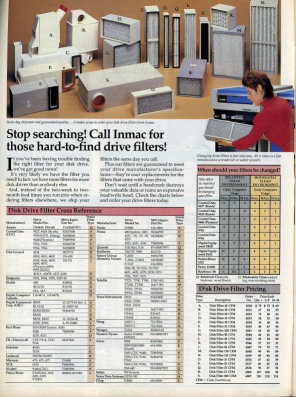
Somebody pinch me.
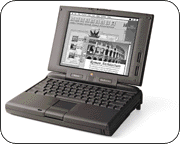 On Monday I did a hack of a NES that I will be posting an article about soon, but I’m already hungry for my next project. I’ve caught the hacking bug, I tell ya — since I finished my last project I’ve been compulsively and obsessively looking at every object in my house in a new way, asking myself “How can I chop that device into pieces and turn it into something more interesting?” Lurking in the bottom of a closet I found an ideal candidate for a hack: an old Apple PowerBook 190 (Apple’s last 680×0 machine, circa 1995) that I bought at a local hamfest for $10 a few years ago. It works fine except for a broken screen hinge. Since it’s “broken” I thought it would be a good choice to play with.
On Monday I did a hack of a NES that I will be posting an article about soon, but I’m already hungry for my next project. I’ve caught the hacking bug, I tell ya — since I finished my last project I’ve been compulsively and obsessively looking at every object in my house in a new way, asking myself “How can I chop that device into pieces and turn it into something more interesting?” Lurking in the bottom of a closet I found an ideal candidate for a hack: an old Apple PowerBook 190 (Apple’s last 680×0 machine, circa 1995) that I bought at a local hamfest for $10 a few years ago. It works fine except for a broken screen hinge. Since it’s “broken” I thought it would be a good choice to play with.
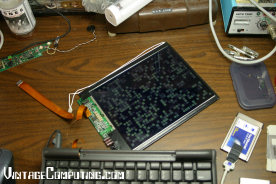 A lot of people are making their own digital picture frames out of old laptops these days (mounting a laptop screen in a picture frame with the computer behind it to hang on the wall and display a random picture slide show), but my 190 only has a 4-bit greyscale passive matrix display, so pictures won’t look too impressive on it. It would be cool to make a semi-permanent, wall-mountable installation out of it, but what would it display? Well, if I could get a reliable network connection to it, it could be a window on all kinds of things on the net, displaying activity from my MUSH, weather info, VC&G traffic statistics, news, or any number of things, as long as there is an application that runs in Mac OS System 7.5.2 to display it. My fiance suggested a permanent digital ant farm, which is a great idea, but I still haven’t found a program or screen saver for the classic Mac OS that simulates one in an aesthetically pleasing way. A friend of mine suggested that I put some form of Linux on it and then I could do all sorts of network-related things that are not as easily achieved in Mac OS 7. But putting Linux on a Mac this old and getting it to work — especially with some ethernet adapter — is a challenging project unto itself. So I’ve been tinkering and I’ve got some new ideas, but I’ll wait until I’m done to share them with you (I’ll give you a hint — well, kinda — just look at the picture above). Until then, I ask you: what should I hack my PowerBook 190 into? Ideas? Suggestions? Leave me a comment and we’ll talk!
A lot of people are making their own digital picture frames out of old laptops these days (mounting a laptop screen in a picture frame with the computer behind it to hang on the wall and display a random picture slide show), but my 190 only has a 4-bit greyscale passive matrix display, so pictures won’t look too impressive on it. It would be cool to make a semi-permanent, wall-mountable installation out of it, but what would it display? Well, if I could get a reliable network connection to it, it could be a window on all kinds of things on the net, displaying activity from my MUSH, weather info, VC&G traffic statistics, news, or any number of things, as long as there is an application that runs in Mac OS System 7.5.2 to display it. My fiance suggested a permanent digital ant farm, which is a great idea, but I still haven’t found a program or screen saver for the classic Mac OS that simulates one in an aesthetically pleasing way. A friend of mine suggested that I put some form of Linux on it and then I could do all sorts of network-related things that are not as easily achieved in Mac OS 7. But putting Linux on a Mac this old and getting it to work — especially with some ethernet adapter — is a challenging project unto itself. So I’ve been tinkering and I’ve got some new ideas, but I’ll wait until I’m done to share them with you (I’ll give you a hint — well, kinda — just look at the picture above). Until then, I ask you: what should I hack my PowerBook 190 into? Ideas? Suggestions? Leave me a comment and we’ll talk!
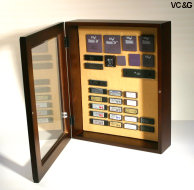 Apologies for the lack of updates recently. Alas, life surely gets in the way when you’re running a free “blogazine” in your spare time. Some ambitious articles are in the works, so stay tuned. Meanwhile, I’ve been meaning to share this with VC&G readers for months: it’s my somewhat underwhelming microprocessor and PC BIOS collection. Why underwhelming? Because it’s composed mostly of easy to find x86-compatible processors so far. I am almost more proud of the case than its contents at the moment (cases like the one pictured can be had cheaply at places like Target or craft stores for around $12-$15 US). I could add some more interesting CPUs if I was willing to rip the brains out of my old computers (which, in general, I’m not). But I do have something like six nasty C-64s sitting around, so I should at least add a 6510 to my collection. My favorite part is the 64-pin Motorola 68000 chip that I painstakingly de-soldered from a surplus Mac Plus motherboard some years ago. I’ve always wanted one of those loose because of their unique package size (not among 68000s, but among DIPs in general).
Apologies for the lack of updates recently. Alas, life surely gets in the way when you’re running a free “blogazine” in your spare time. Some ambitious articles are in the works, so stay tuned. Meanwhile, I’ve been meaning to share this with VC&G readers for months: it’s my somewhat underwhelming microprocessor and PC BIOS collection. Why underwhelming? Because it’s composed mostly of easy to find x86-compatible processors so far. I am almost more proud of the case than its contents at the moment (cases like the one pictured can be had cheaply at places like Target or craft stores for around $12-$15 US). I could add some more interesting CPUs if I was willing to rip the brains out of my old computers (which, in general, I’m not). But I do have something like six nasty C-64s sitting around, so I should at least add a 6510 to my collection. My favorite part is the 64-pin Motorola 68000 chip that I painstakingly de-soldered from a surplus Mac Plus motherboard some years ago. I’ve always wanted one of those loose because of their unique package size (not among 68000s, but among DIPs in general).
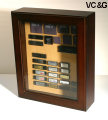 So far in my collection I have the following (from left to right, top to bottom): Intel A80486SX-25, Intel A80486DX-33, Intel A80386DX-25 (x2), Intel P8080A, Intel D80287-10 (co-processor), IIT 3C87-40 (386 clone, I think), Intel R80286-10, Intel CG80286-8, Intel A80387DX-25 (co-prossesor), Motorola MC68000P8. Then I have a bunch of different PC BIOS chips that aren’t all that amazing — the only notable ones are the Phoenix 3.10 chips, and the Mac Plus ROMs (which obviously aren’t BIOSes, but I don’t know where else to put them).
So far in my collection I have the following (from left to right, top to bottom): Intel A80486SX-25, Intel A80486DX-33, Intel A80386DX-25 (x2), Intel P8080A, Intel D80287-10 (co-processor), IIT 3C87-40 (386 clone, I think), Intel R80286-10, Intel CG80286-8, Intel A80387DX-25 (co-prossesor), Motorola MC68000P8. Then I have a bunch of different PC BIOS chips that aren’t all that amazing — the only notable ones are the Phoenix 3.10 chips, and the Mac Plus ROMs (which obviously aren’t BIOSes, but I don’t know where else to put them).
If anybody wants to donate some CPUs to the VC&G Microprocessor collection, let me know. 🙂 Also, if you have a collection yourself, feel free to show us some pictures or discuss it in the comments.